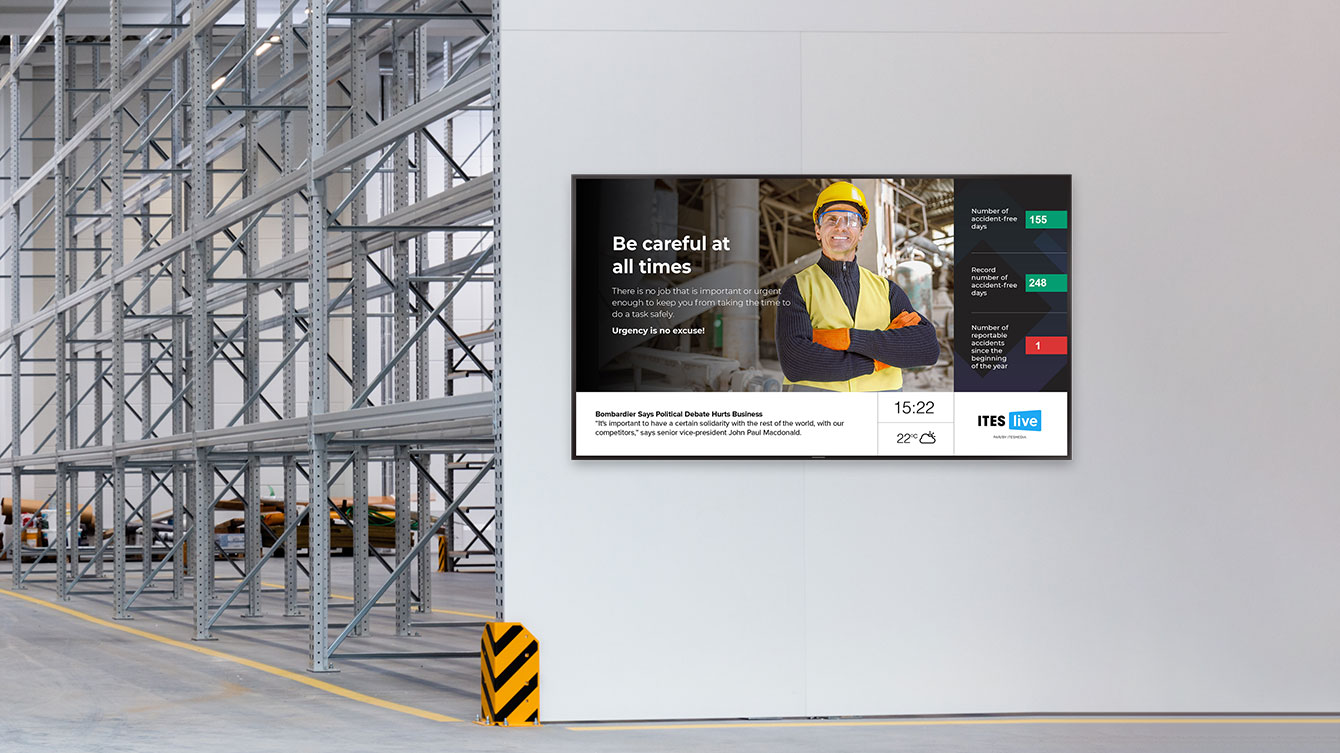Business communicators who want to drive meaningful and timely messaging on their workplace digital signage networks should get to know and embrace a nerdy little acronym - API.
That's short for Application Programming Interface. While that will look both intimidating and boring to people charged with workplace communications, having access to APIs is a big deal for running a digital signage network that is always current, always relevant. and best of all, highly automated. For busy HR pros, it can be a lifesaver, because of the way data can work with software tools to steadily feed the content beast.
Imagine keeping staffers in office areas and out in the warehouse and production areas steadily informed on what's going on, what they need to do, and how things are going, without allocating full-time resources to pull material together and get it all out to screens. Imagine all the complexity gone from tasks like accurate messaging based on things like location, time and operating conditions.
With APIs, that's all not only possible, but relatively easy with the right software solution and technology partnership. In layman's terms, APIs make it possible to securely access real-time data from business systems and cloud-based software platforms. An API presents that data in a reliably structured format, that can then be ingested by a content management system and used to present steadily updated, dynamic content on screens.
Still a little nerdy, we know, but here's how that looks in a workplace:
Those time consuming and boring Spreadsheets and PowerPoint slides that a manager or assistant creates manually, and then prints and posts in break rooms or work team meeting areas, can instead be live content on one or several screens. In a manufacturing environment, that screen might be showing live charts that reflect production numbers against target, inventory levels, or shipping volumes reported by product, production line or whatever variable that's required.
When a sensor connected to production equipment detects a spill, it can automatically trigger a warning notice to screens in that immediate area, with specific instructions for workers. Around the rest of the plant, the notification message might be different, or there may be no need for any messaging about the incident. Contrast that with older systems that might trigger a general alarm that a whole facility will hear and react to, causing downtime.
In a sales office, a screen or screens automate the key performance indicators - like sales pipelines and sales performance against targets - on real-time dashboard screens, instead of being printed out for discussion and review at a weekly sales team meeting.
At a logistics facility, cameras and sensors pick up and report when a truck enters the yard, and then logs on screens when it arrives at a bay, when it loads or unloads, and when it exits the facility. Compare that with a job that's otherwise left to paper sheets and clipboards only a handful of people ever see.
At facility exit areas, automated content can let workers know about traffic problems or transport delays and disruptions, before they leave the premises and end up in a traffic jam they wished they'd known about.
Working with data for your communications can be easy
While all this likely sounds quite technical, and over the head of many human resources people who don't think they missed their calling in IT, working with data is increasingly easy.
That big hurdle - getting at real-time data - is now easy for many to most businesses, particularly those running on contemporary, cloud-based systems. APIs for these types of systems are common, and usually essential now for doing business.
Smart digital signage and interactive solutions companies have developed tools - like data connectors and dynamic content templates - to make it easy. While every business out there is a little bit different, communication needs don't vary as much. Most companies have KPIs they'd like to show on screens. Most companies want to celebrate success and acknowledge team milestones. Most companies want a means to reinforce safety, and a way to report how things are going.

Using something called HTML5 and Java scripting - don't worry, you don't need to learn them either - a content template can be updated instantaneously, and things like charts and graphics re-drawn and images switched, with no intervention from a creative person (or anyone else). Magic!
The right messaging can help boost performance. When a work team is behind on a task, real-time data can show where they're at and encourage speeding up or re-allocating resources. Some companies have taken a cue from online game platforms to "gamify" work tasks - pitting teams across a plant, or multiple plants, to boost productivity with fun visuals and incentives.
The right digital signage solutions providers will have the tools and knowledge to work with customers and come up, usually quickly, with content automation templates. Often, busy IT staffers within an organization need to have little or no involvement when the systems that have the desired information are equipped with APIs.
NO APIs? Message automation is still possible, just ask.
When there are no APIs, that doesn't mean partial or full automation is not possible. First, a solutions provider can work with the technology provider that has the platform and data, to develop custom access. Often, all that's needed is some means to push data to a shared directory that is secure for the tech col, and accessible by an outside system.
It's also possible to strip down and simplify automated messaging. Something as simple and ubiquitous as Google Sheets spreadsheets can be used. For example, if a company wants to post production target numbers at the start, middle and end of each shift, someone just needs to key those in to the right cells on the shared spreadsheet, and the CMS platform will "see" the changes and speedily, if not instantly, change that on screens, in numbers and charts that can grow, shrink and change color based on the design and pre-set parameters.
How to get started with automating workplace messaging
So how does an organization start optimizing and automating critical workplace messaging?
Three key steps:
- Establish what messages are needed, where they need to be, and how often they change;
- Determine where the information is generated and resides, and whether it is accessible (i.e. has an API);
- Find a solutions provider that understands how to work with real-time data and has a track record of doing so for organizations.
The most successful workplace digital signage projects are those that are steadily fresh, timely, relevant and visually interesting. Done manually, it would be a lot of work. But with the right toolsets and tech partners, it should be a breeze. And much-loved around the organization.








